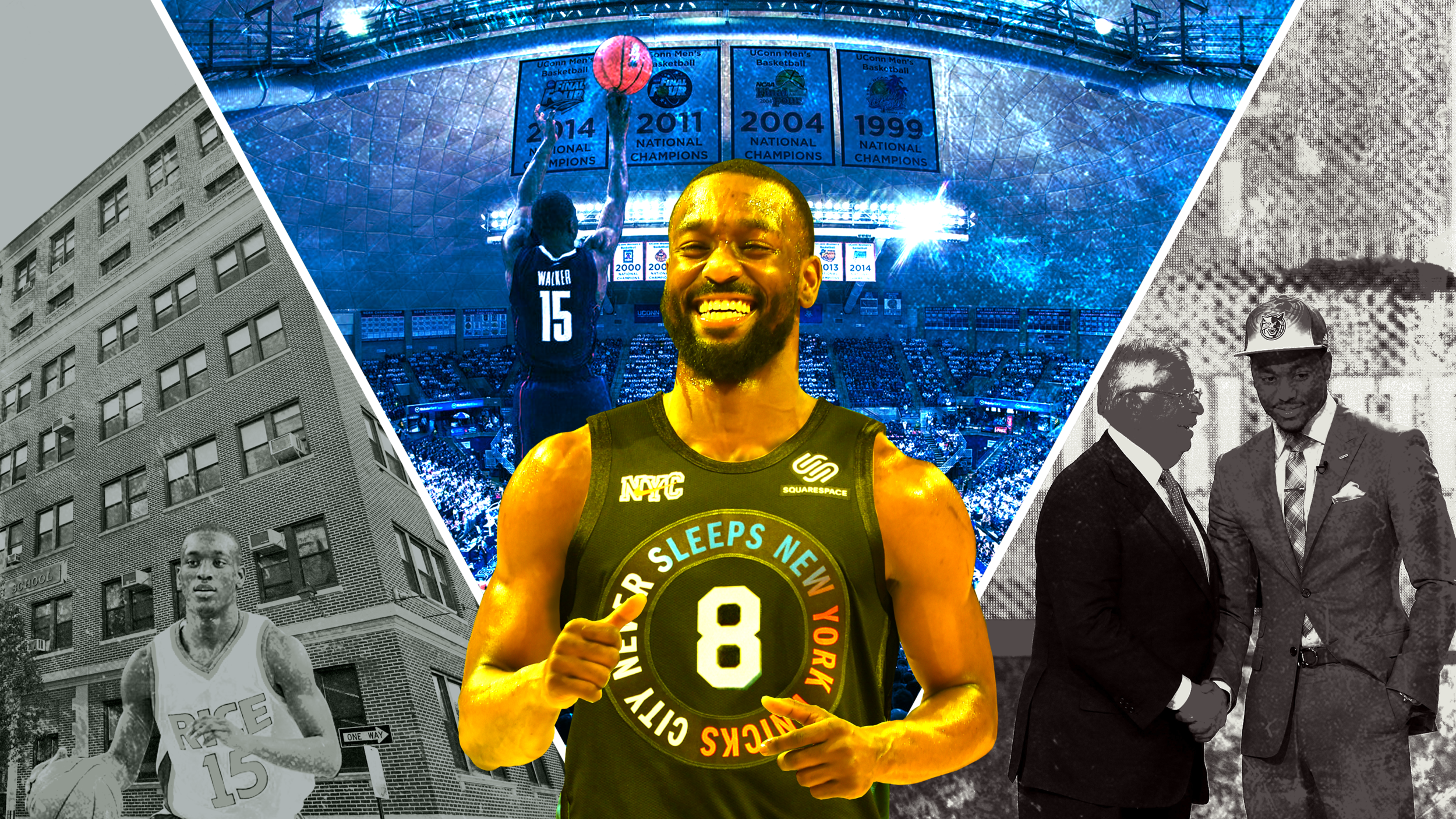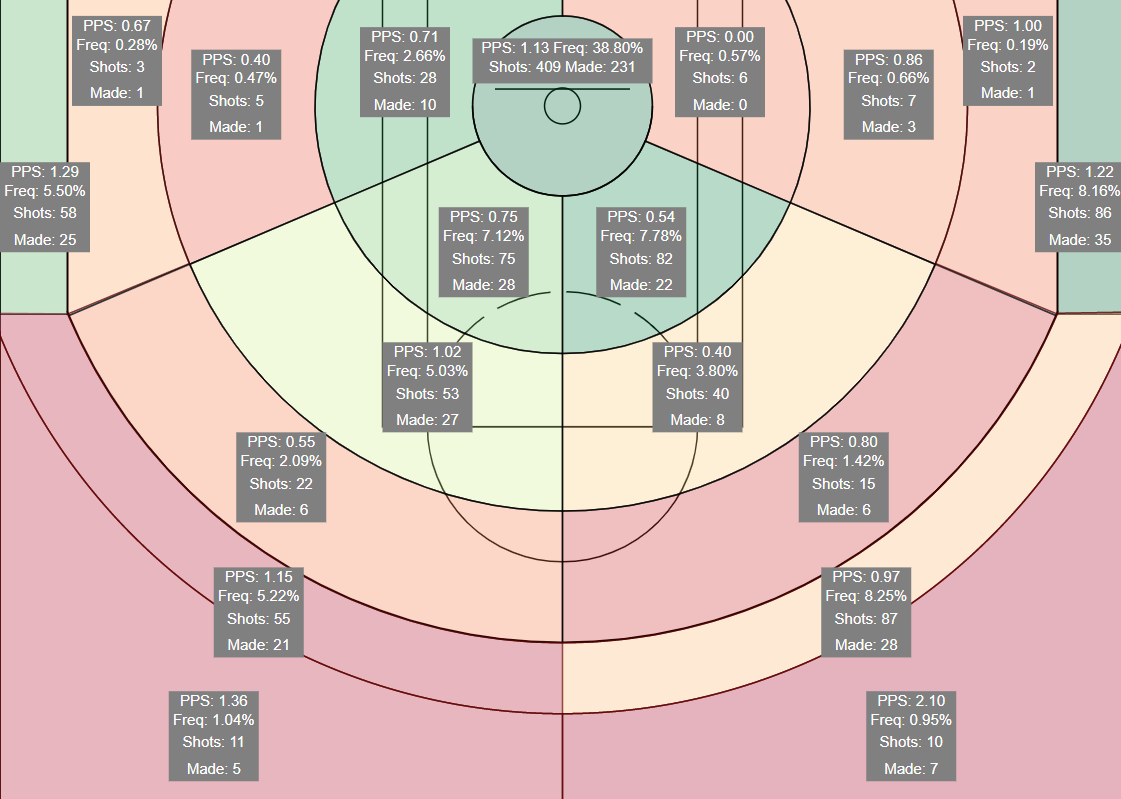Kemba Walker is coming home, Part 1: Fit
Kemba Walker is a New York Knick. The four-time All-Star is presumably a fit on any team, but just how perfect is he for this Knicks team?
Got a mismatch!
Walker, on McGhee with four.
Kemba Walker — stepback — Walker — CARDIAC KEMBA!
Yes: Kemba Walker, who grew up in the Bronx, went to high school in Harlem, and hit that shot heard round the world in Midtown, is returning to the Mecca to play point guard for the New York Knicks.
Walker, even coming off a couple of disappointing seasons in Boston, immediately projects as the best point guard the team has had since — at the earliest — Raymond Felton in 2012-13. He’s a four-time All-Star still putting up a nonchalant 20 and five, and is still younger than you might think — at 31, he’s just two months older than Damian Lillard.
Of course, being a good player doesn’t automatically make you a good asset to a basketball team. On his original contract, Kemba had two years left at an average annual value of almost $37 million; the 17th-biggest number in basketball. If the Knicks had signed him to that deal during this free agency period, it would have been universally — and rightfully — panned.
But he’s not on that contract — although at the time of this article being written the terms hadn’t been officially reported, it would be near-impossible for the deal to be greater than about $10 million AAV due to remaining salary cap, and reports indicate it’s a two-year deal at around $8 million per. Even if he’s a half step slower, and his knee keeps him out a few games, he’d still be by far the best value at that dollar amount currently available to the Knicks on the free agent market, which had by Wednesday morning essentially dwindled to Dennis Schroder alone like Will Smith at the end of the Fresh Prince of Bel-Air.
Even aside from his obvious skill and minuscule salary, Kemba is a near-perfect fit for this Knicks team. Just how snug of a fit? See RJ Barrett’s shot frequency chart this past season per NBAShotCharts.com below (green means more attempts; red means fewer):
Here’s Kemba’s:
Like a glove.
More importantly, Kemba fits the big-picture plans of the Knicks’ front office brass. After their offense was locked up by Atlanta in their triumphant return to the playoffs, New York’s offseason priority was clear: more on-ball creating guards to take pressure off Julius Randle and open easier offense for Barrett. They showed trade interest in Collin Sexton, and signed Derrick Rose and Evan Fournier to big-money deals. They chose to retain Alec Burks, more of an on-ball creator, over Reggie Bullock, who allowed Trae Young to hide on him in the corner for five games, at essentially the same three-year, $30-ish million contract.
To get even more granular… you may have noticed by now, but the Leon Rose Knicks have a real thing for pull-up shooting. Their draft history — Immanuel Quickley, Quentin Grimes, Miles McBride — underscores their free agency decisions of Burks (twice), Austin Rivers, and Fournier. It’s a good priority to have; maybe the most important skill in 2021 NBA basketball considering how much it opens both individual and team offense, and the main reason I once deemed Immanuel Quickley the Knicks’ best asset.
The only NBA players who attempted more pull-up threes per game than Kemba this past season? Damian Lillard, Stephen Curry, Luka Doncic, James Harden, CJ McCollum, and Donovan Mitchell.
However, considering so much of that skill was already peppered around the roster, many thought that from a fit perspective, New York should target rim pressure with its remaining cap space — hence interest in Schroder.
Leon Rose found a way to have his cake and eat it too in Kemba, who ranked in the 91st percentile league-wide in getting to the rim and in the 99th percentile in 3-point shot creation this past season, per BBall Index. Not even taking into consideration what the signing does for the depth and continuity of the Knicks’ bench, it just adds more and more diversity of skill and advantage creation to their core lineup. Again per BBall Index, talent percentiles for the Knicks’ starting lineup on opening night of the playoffs:
Compared to their projected starting lineup next season:
They’ve given up a bit on the margins in spacing and finishing, and made massive strides in adding playmaking and rim pressure.
The biggest challenge will be getting this new Knick team to keep up with last year’s incredible, maybe outlier, defense — it’s highly unlikely given the new personnel, but you can be sure Thibs will wring the towel dry with this group; if he can turn Derrick Rose and Burks into neutral team defenders, anything is possible.
Back to Kemba himself — his nagging left knee is still a concern, but it’s really the biggest one. Poor press for his Boston run was due mostly to high expectations, a big contract, and Kyrie Irving-sized shoes to fill. The production really hasn’t fallen off just yet — in fact, three of his nine highest-scoring games as a Celtic all came this past May. Let’s deep-dive one of them — a 36-point explosion against the defensive-minded Heat on national TV.
Warning: Knicks fans who have spent decades watching Chris Duhon, Emmanuel Mudiay, and Elfrid Payton may be extremely sensitive to this footage.
Let’s jump into it: watch Kemba’s awareness here to attack the switch before it fully sets into its mold, using a quick first step and a steady left-handed dribble to easily get into the paint, before pump-faking the big in the air and hitting a soft-touch jumper:
You can already see this next play developing in the (real) Garden: Randle drives, draws the double, kicks out to Fournier (a threat from deep), who makes the quick read and swing to Kemba (also a threat from deep), splash:
Kemba #KnowsBall. When you have the full array of skills in shooting, handling, passing, and finishing, and are mentally in command of them, you can pull off plays like this:
Good enough shooter to be a threat for the closeout — so a pump fake gets him by Nunn. Good enough handler and passer to both get into the lane and freeze Herro for a split second with the threat of the pass. Good enough finisher to float it up and in in traffic despite his 6-foot stature.
Don’t mind me. Just thinking about what having this guy in the gym every day can do for Immanuel Quickley’s game.
It’s not just from a standstill, either — his drive-and-dish game is really opened up by his aforementioned pull-up shooting ability, a threat that gets him into the lane with ease, over and over again, where he draws anticipated help and finds teammates:
He can really play-make — here, Miami tries to take advantage of his small size to double him up top and force a turnover, but he’s on time and on target with this nifty pocket pass:
Again, that’s a pass that’s opened up by his perimeter ability. Hard to see a double 26 feet away from the cup on Payton — or Schroder, for that matter.
Alright, I completed my film quota. I’ve earned my advanced impact metric privileges:
There really isn’t an analytical number I can find you that doesn’t show what a significant boon the Bronx native is to this Knicks team. To visualize it, take a peek at the DARKO predictive metric true talent tool, and compare Kemba to last year’s starter and this year’s starter in an alternate universe:
Anyone still too concerned about that slight taper in recent production? Kemba’s really in the same breath as the league’s elite point guards here:
In the end, this may be much ado about nothing. Unless your name is Max Kellerman, you don’t need pages of stats, charts, and video to tell you a recent All-Star at a position of need is a coup with the Knicks’ little remaining cap space. Sure, the Knicks certainly aren’t championship contenders yet — but they don’t think they are. Instead of going all-in, they’ve prioritized continuity from last season, archetypes of need for immediate improvement, and future draft/contract flexibility (especially considering recent news of team options on this summer’s deals) — keeping the powder dry for a competitive team now and a potential big move later. They just extended their star, Julius Randle, for below market value. If this is indeed the end of New York’s offseason, it ended on a high note.
Welcome home, Kemba.









